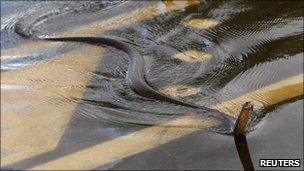Snake risk for flooded Queenslanders
- Published

Snakes have been spotted seeking higher - and dryer - ground
Flushed out by Queensland's rising flood waters, deadly snakes are on the move in the region's cities and towns.
There are also fears that crocodiles are now floating in flood waters. Residents have been advised not to enter the waters.
The Australian state of Queensland is home to some of the world's most venomous snakes, including the Common or Eastern Brown snake, the Coastal Taipan and the Death adder, as well as saltwater crocodiles - among the largest of the species, and a notorious man-eater.
But now some of these dangerous creatures are on the move and the likelihood that they will come into contact with humans is increased.
Venomous snakes are climbing trees, seeking cover in homes and outbuildings and trying to find higher, dryer ground, meaning that the same number of snakes will be present in a smaller area.
Crocodiles too are dispersing, the limits of their natural habitat now vastly expanded.
Snake anti-venom
Ian Stephen, a reptile and amphibian specialist at the Zoological Society of London, said the transformation of the natural habitat might have an impact on their behaviour.
"Their whole landscape has changed," he explained.
The ҙуПуҙ«ГҪ's Nick Bryant: 'We just saw a snake nearby'
"Snakes have been reported to be a lot more cranky but with the crocs, it will bring them more into contact with people. Before, they were just restricted to estuaries and not that far inland, in the major rivers, but now their habitat is just massive."
The mayor of the city worst-affected by the floods, Rockhampton, says residents have reported seeing more snakes than usual, as well as the odd saltwater crocodile in the flooded Fitzroy River.
"We do not think they are a risk to public safety if people keep out of the waters, but if people do enter the waters their safety cannot be guaranteed," Brad Carter told newspaper.
Along with food and clean water, shots of snake anti-venom are reported to be among emergency supplies being flown in by helicopter to the area.
Kris Foster, a professional snake-catcher based in the Queensland city of Gladstone, some 100km (62 miles) south-east of Rockhampton, said the risk was real.
"We do have the the second most venomous snake in the world that lives in the area - the ," he said.
According to the Queensland Museum, the highly venomous snake can be pugnacious when provoked and rear up in a distinctive "S" shape. Mr Foster emphasises that although it may appear highly aggressive, the snakes are actually very nervous and will only attack when they perceive danger.
'Shy snake'
"Most of the time they try and get out of the way," he said of the Eastern Brown Snake. His advice to anyone who spots any kind of snake is not to try and tackle it in case it is venomous.
"We also have - they are a very shy snake and they don't like being around people - I've only come across 14 of them in the last 10 years," he said.
The Death Adder - very rare, but very dangerous
"There is also the , they are very scarce but they're among the fastest-striking snakes on the planet. They hide under leaf litter and use their tail as a lure, rippling it in front of the prey."
Snakes, whose bodies rely on the warmth of the sun to warm them and speed digestion, are more active in the summer months, he says. He adds that the intense rain will have cooled the environmental temperatures, meaning they are probably calmer.
"At the moment, the temperatures are down, their metabolic rate has slowed down, their bodies aren't chewing a lot of food, they aren't seeking food," he said, explaining that in these conditions snakes can often go for several weeks, and even months, without eating.
Meanwhile, the saltwater crocodiles indigenous to the Queensland area may be getting hungry, Mr Stephen says.
"Only the larger ones are capable of killing. The more hungry they are, the greater the likelihood of an attack. When it is high water, it is harder for the crocs to get food."
Among the largest of the crocodile varieties, they grow - over the course of decades - to up to six or seven metres in length.
But, despite their aggression, he agrees that the principal risk to Queenslanders is likely to be snake bites rather than crocodile attacks.
"Snakes are only aggressive when they are cornered and they have nowhere to run, but, unfortunately, that is the situation now, you are more likely to come across a grumpy and dangerous snake."